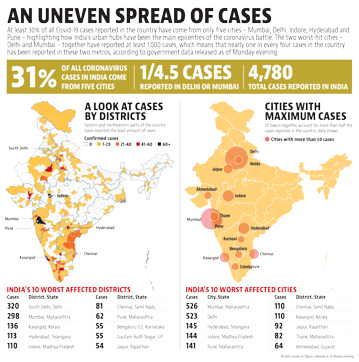Covid-19 update: The ‘ruthless containment’ model of Rajasthan’s Bhilwara
India’s cabinet secretary Rajeev Gauba praised Rajasthan for the Bhilwara model.
Bhilwara district, which was once among the 10 coronavirus disease (Covid-19) hot spots in the country, is now being talked about for its ‘ruthless containment’ model.

In the video conference with chief secretaries of states, India’s cabinet secretary Rajeev Gauba praised Rajasthan for the Bhilwara model, said Rajasthan chief secretary DB Gupta. “The government is planning to implement this model in other places, too, for effective containment of the infection,” he said.
Click here for the complete coverage of the Covid-19 pandemic
The Bhilwara model of containment worked in phases. The first task was to isolate the district, second was screening strategy in city and rural areas and third was quarantine and isolation wards, followed by monitoring mechanism for rural areas, said Rajendra Bhatt, district collector, who led the team of government staff in this ‘war against Covid-19’.

For isolating the district, curfew was imposed in the district on the day the first case was reported. This was from March 20 to April 2. During this period, essential services were exempted from the order.
“We sealed borders of the district and set up check posts at all entry and exit points. Roadways and railway services were stopped and movement of private vehicles prohibited,” Bhatt said.
After isolating the district, the administration defined the containment zone of 1km from the epicenter – Brijesh Banger Memorial Hospital (BBMH), a private institution, who doctors and staff were the first ones to test positive – and buffer zone of 3km. Similar, containment and buffer zones were also created around the house of a positive patient.
“On the basis of cluster mapping, we identified six areas and deployed special teams for continuous screening of suspected cases in these,” the collector said.
During this phase, disinfection of the following was done on a daily basis: containment zone and buffer zone; locality of positive cases; all ambulances and police vehicles; screening centre and quarantine centre; collectorate, police line and public dealing offices; and city wards.
In the second phase of curfew, from April 3 to April 13, even essential services are prohibited in the city. “During this period, there’s no relaxation of any type. We are ensuring door to door supply of essential items such as vegetables, fruits and milk to residents and food packets to the poor,” Bhatt said.
For screening, survey teams trained by specialized doctors regarding Covid-19 ILI (influenza-like illness) symptoms, checking persons having foreign travel history and prioritizing epicenter affected population as well as migratory population. There is a supervisor for every 10 survey teams.
“Screening and testing was prioritized for Brijesh Banger Memorial Hospital. ICU admissions, doctors and nursing staff, IPD and OPD patients, persons who were identified to have had contact history with the positive cases, health workers and other staff were screened and all suspected cases told to be in home quarantine,” the collector said.
He said a dedicated screening and testing centre was established at MG Hospital, which was dedicated as Covid hospital. People were brought to these cntres for screening and testing in government vehicles and dropped back. “In screening, doctors and nursing staff did thermal scanning and physical examination. If anyone had symptoms or was contact of a positive patient, his samples were drawn and he was sent in isolation,” Bhatt said. He said every day, government vehicles carried these samples to Jaipur for testing, thrice a day.
For every positive patient, the close contacts were brought to isolation wards and the tier-2 contacts were taken to institutional quarantine facility. The district administration used 1,541 rooms of 27 hotels as quarantine centres.
Apart from the hotel room, the administration also had 11,659 quarantine beds in 22 institutions and hostels. MG Hospital has 200 beds. The capacity could be extended up to 427 beds. Four private hospitals with isolation ward capacity of 25 beds each were also acquired.
For monitoring, Bhatt said, corona fighters and corona captains were appointed in city and rural areas. In city, sub-divisional magistrate (SDM) is the corona caption and ASHA and ANM are corona fighters. In the villages, block development officers (BDO) and tehsildar are corona captains at the level of panchayat samitis and sarpanch, panchayat sahayak, teachers and ASHAs are corona fighters at village level.
“Corona captains and corona fighters monitor people in home quarantine, ensure food supplies, food packets, flow of migrant labourers and law and order,” collector said.
Bhatt said while in other cities, source of Covid-19 infection was known, in Bhilwara, it is unknown from whom the doctor got infected. Ask him to sum up his efforts in one line and he says, “Ruthless containment model and cooperation of people in our war against Covid-19.”






